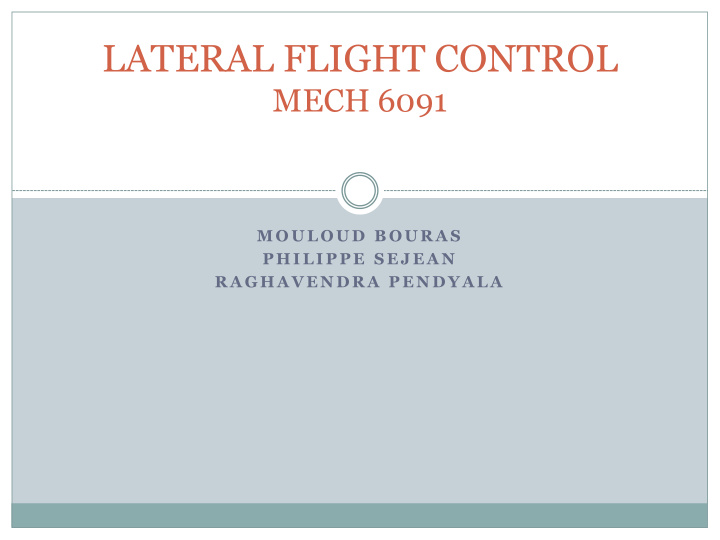



LATERAL FLIGHT CONTROL MECH 6091 M O U L O U D B O U R A S P H I L I P P E S E J E A N R A G H A V E N D R A P E N D Y A L A
Project overview Introduction Equations of Motion Non-Linear and Linear Modeling Autopilot design and Simulink Demonstration Results and Discussion
Introduction Objective: Design a control system for an existing aircraft for lateral motion. Matlab/Simulink software is used to implement design and test for the designed autopilot control system.
Introduction
Introduction STOL transport data was used from R.Nelson Flight Stability and Automatic Control textbook to test the control system.
Assumptions
Equations of Motion Equations of motion are found applying Newton’s second law: The forces considered for lateral motion are: Fa: Aerodynamic forces acting on the vertical tail. T : Thrust pushes forward along the length of the aircraft D : Drag pulls back along the length of the aircraft W : Weight The Moments considered for lateral motion are: Rolling moment L about the C.G. Yawing moment N about the C.G.
Equations of Motion Dynamic equations: Kinematic equations:
Nonlinear Model The above Equations are derived from the dynamic and kinematic equations based On the following assumptions: Angle of attack (α) is small and constant. Pitch angle (θ) and the rate of the change of pitch angle (Q) are zeros.
Linear Model For the linearization the Jacobian matrix is used and the states and inputs control of the model is specified as: However the controller should keep the constant the velocity, the thrust is not included as input control since it is assumed enough to get constant velocity and all initial conditions are zeros. State space representation of the linear model as this form
Linear Model A and B are Jacobian Matrices
Linear Model
LQR Controller Linear-quadratic Regular LQR controller was used for the lateral control system. Linear quadratic Regulator Controller is the best controller signal to bring the system from an initial state to the steady state . As we know the choosing of weighting matrix (Q and R) are very important and to minimize the cost function according to this function:
Simulink Model The block contains the nonlinear aircraft dynamics
Simulink Model Subsystem produces the Moments N,L
Simulink Model NonLinear simulink model of the Autopilot system
Simulink Model Linear simulink model of the Autopilot system
Time Response: linear vs nonlinear Linearized model time reponse for y0=10 Non-Linear model time reponse for y0=10
Linear System Results For y0=1 and δ a=0.005
Non-Linear System Results For y0=1 and δ a=0.005
linear vs nonlinear control 12 nonlinear model linear model 10 8 y-position 6 4 2 0 0 500 1000 1500 2000 2500 x-position
Conclusion The general equations of motion were developed for the lateral motion of an aircraft. The equations were linearized. Simulink models were built for both linear and non- linear models of the autopilot control system. Comparing the response of the reference input y for both linear and non-linear has shown that the controller works well for both systems.
REFERENCES [1] Youmin. Zhang, Lecture Notes on Flight Control system, Concordia University, 2010. [2]B.L. Stevens, F.L. Lewis. Aircraft Control and Simulation, 2 nd edition [3] R. Nelson. Flight Stability and Automatic Control, 2 nd edition [4] http://en.wikipedia.org/wiki/Stability_derivatives. [5] http://en.wikipedia.org/wiki/Linear-quadratic_regulator
Recommend
More recommend